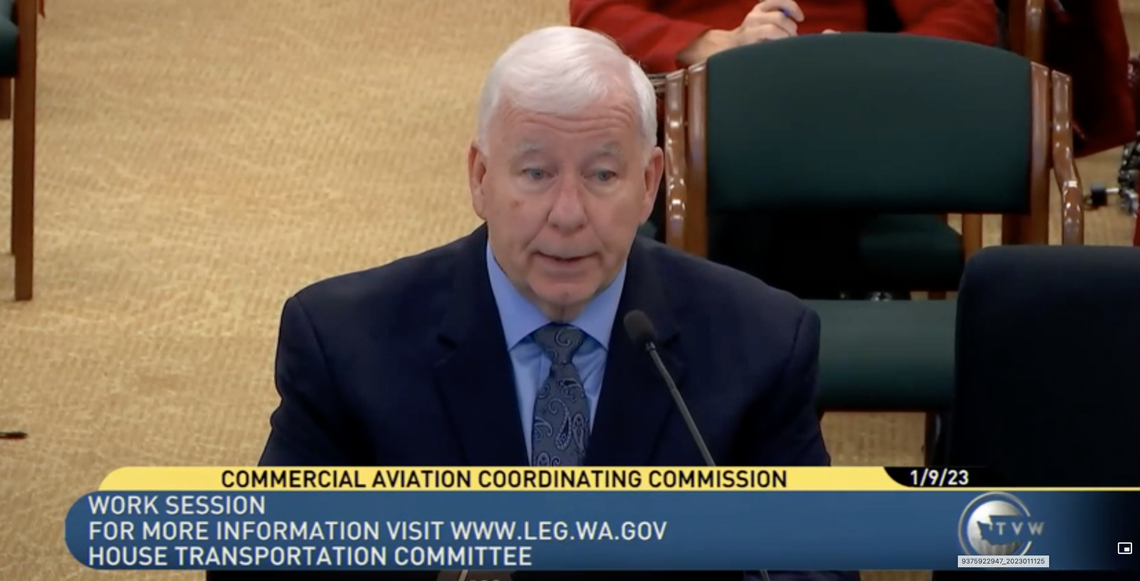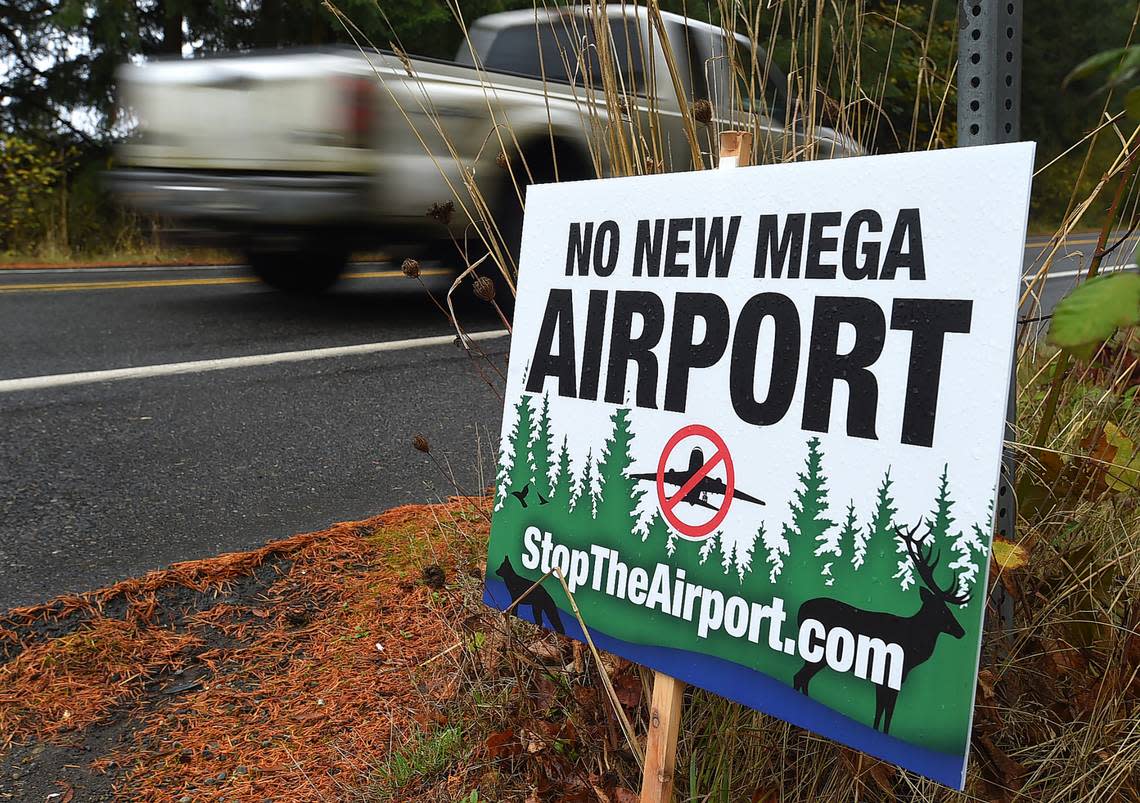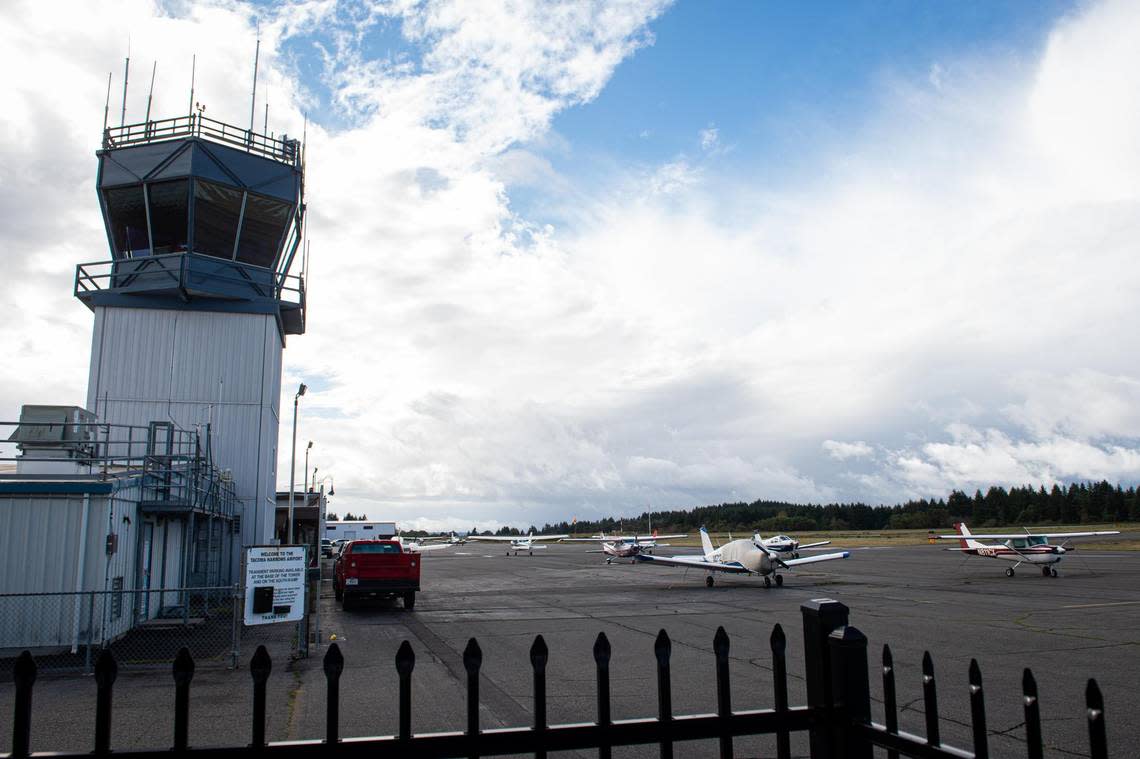Use existing airports or build from scratch? This Puget Sound question is a math problem
The magic number is 27 million.
It is the number of annual passengers that the Puget Sound is projected to be unable to serve by 2050 if the region’s flight-operation capacity does not increase.
It is the deficit that members of a state-created commission are trying to close.
It was a significant factor in what brought two rural Pierce County sites to the forefront in the search for a potential new two-runway airport’s landing spot in Washington.
Twenty-seven million is also the figure that has, in large part, disqualified what was once considered a possible alternative to building from scratch.
“Three years ago, we thought we could maybe solve this with local airports that exist,” Warren Hendrickson, the acting director of the Commercial Aviation Coordinating Commission, said during a virtual CACC meeting last month. “We know that we can’t. And so now, how do we site this?”
Expanding existing airports would not cover the deep gap in available domestic-passenger service that the Puget Sound is expected to face in fewer than three decades as the region continues to grow, Hendrickson said in an interview this week.
“That capacity would only put a small dent in the total capacity needs,” he said. “Is that acceptable?”
It is why officials have focused efforts on a new primary commercial aviation facility that could accommodate more travelers. The price tag might be as high as $24 billion, but a do-nothing approach could cost $31 billion in annual economic impact, he told the House Transportation Committee on Monday.

Hendrickson told The News Tribune that existing airports were generally estimated to be able to handle no more than five million annual passengers each. It meant that it would require four or five of them to meet the needed capacity, assuming some could adopt commercial flight service at all. From a business standpoint, it would be impractical for airlines to operate in as many places in one region, he added.
Conversely, of 10 so-called greenfield sites — the name given to plots of undeveloped land considered for siting a new airport — five were determined to be equipped to service more than 19 million annual passengers within a 90-minute drive, according to state consultant Kimley-Horn.
They included two six-mile diameter areas in Pierce County — one south of Puyallup and another east of Roy — that were estimated to be capable of supporting 20.8 and 19 million annual passengers, respectively.
Three other greenfield sites analyzed by Kimley-Horn were deemed capable of similarly large-scale capacities, but none of those locations in King or Snohomish counties made the short list of finalists in September.
King County was never on the table because state legislation that launched the current airport review process also exempted from consideration any location in that county, which is home to Seattle-Tacoma International Airport. Two Snohomish County sites were dismissed during deliberations since plans remain alive to expand Snohomish County Airport (Paine Field) to as many as 4.3 million annual passengers from the roughly one million it sees now.
“It doesn’t make a lot of sense to try and build a new greenfield site in a region where there already is potential for additional capacity in that same region,” Rob Hodgman, senior aviation planner for the state Department of Transportation’s Aviation Division, said during a CACC meeting in September.
With capacity being the key issue in trying to solve the problem at hand, the two Pierce County sites became attractive for a potential 3,100-acre facility capable of serving not only domestic commercial passenger needs but also projected cargo growth. Demand for cargo is estimated to more than double by 2050, according to a May 2021 study by the Puget Sound Regional Council.
A location in Thurston County, east of Olympia, also is under consideration despite partly overlapping with Joint Base Lewis-McChord and with projections showing it could take on fewer than 8 million annual passengers. During the CACC meeting last month, Hendrickson noted those glaring weaknesses but said that the commission felt uncomfortable with “just having the two Pierce County sites as the only greenfield sites to consider.”

Not merely a capacity issue
The commission, tasked with making a feasible airport site recommendation to state lawmakers by June, has encountered local opposition and major logistical obstacles while weighing use of existing airports — similar to those stemming from its controversial consideration of greenfield options.
Still, some state lawmakers have said that airports already in the region needed more deliberation and were underutilized. House Republican Leader Rep. J.T. Wilcox, R-Yelm, told The News Tribune last month that he would rather have airports chip in to bridge the projected passenger service shortfall than to see a new hub built that disturbs land and people.
In an appearance in September on TVW’s “Inside Olympia,” state Sen. Karen Keiser, D-Des Moines, and Rep. Tom Dent, R-Moses Lake, said that the commission had discussed using JBLM as a joint-use military-civilian airport. Dent said the option “could really work” but acknowledged it would require convincing military and government officials.
The bill that set into motion the current process, which was sponsored by Keiser and unanimously approved in 2019, precluded siting a new airport “on or in the vicinity of a military installation that would be incompatible with the installation’s ability to carry out its mission requirements.”
Hendrickson told The News Tribune that the commission has to get JBLM, the Department of Defense and the state’s congressional delegation involved in the process to determine what role the base can play.
Pierce County, which is adamantly opposed to siting an airport within its borders, had said it did not want Tacoma Narrows Airport debated for potential expansion to support commercial passenger service or air cargo, Hendrickson said.

Olympia Regional Airport had been in the mix but its inclusion resulted in similar pushback from local officials, according to Hendrickson, who is the airport’s senior manager.
In fact, of six airports reduced from an initial list of 18, only Paine Field was deemed viable by the commission for assisting commercial passenger service needs, according to a CACC presentation from August. Others, such as Arlington Municipal and Tacoma Narrows airports, were being reviewed at that time only for potentially increasing general aviation operations.
Bremerton National Airport had been considered as late as August for expanding general aviation and — along with Paine Field — air cargo capacity. But even meeting projected cargo demand would be difficult without a commercial passenger component since 40 percent of all cargo is carried in the belly of passenger airplanes, Hendrickson told The News Tribune.
In some instances, an existing airport has been scratched from consideration because of its distance from the Seattle metropolitan area or other transportation hurdles, he said.
In short, the number of passengers that a site could serve decreases the farther it is from the state’s main population center.
Recently, the city of Yakima offered Yakima Air Terminal-McAllister Field for study as a potential expansion option, becoming a rare example of a local government volunteer, which Hendrickson said was “great.”
He also cautioned that the airport’s location — roughly 160 driving miles from Tacoma — created the exceptional challenge of figuring out how to move 55,000 people a day to Yakima.
In a presentation delivered to the state’s House Transportation Committee on Monday, Hendrickson gave an overview of the current situation and offered CACC’s conclusion after it had finished one analysis earlier in the broader process.
“Can the required capacity be met by existing airports?” he said. “That answer: No.”
